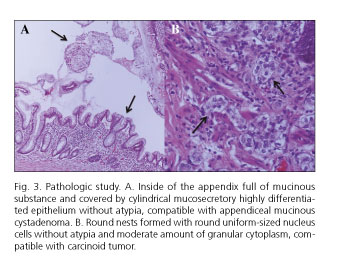Mi SciELO
Servicios Personalizados
Revista
Articulo
Indicadores
-
 Citado por SciELO
Citado por SciELO -
 Accesos
Accesos
Links relacionados
-
 Citado por Google
Citado por Google -
 Similares en
SciELO
Similares en
SciELO -
 Similares en Google
Similares en Google
Compartir
Revista Española de Enfermedades Digestivas
versión impresa ISSN 1130-0108
Rev. esp. enferm. dig. vol.109 no.2 Madrid feb. 2017
PICTURES IN DIGESTIVE PATHOLOGY
Diverticulitis of the appendix as debut of appendicular cystadenoma and carcinoid tumor
Debut de cistoadenoma apendicular y tumor carcinoide como diverticulitis del apéndice cecal
Laura Fernández-Gómez-Cruzado, Mikel Prieto-Calvo, Christian Pérez-González and Jasone Larrea-Oleaga
Department of General Surgery and Digestives Diseases. Hospital Universitario de Cruces. Barakaldo. Vizcaya, Spain
Case report
A 36-year-old man was admitted to the Emergency Room with a four-day-old right lower quadrant pain without signs of peritoneal irritation. A blood test showed 1.57 mg/dl CRP and 9,700 leucocytes/mm3. CT (Fig. 1) evidenced appendicular diverticulitis in the context of appendicular mucocele. Surgery was decided upon and an open appendectomy was performed, confirming the radiological findings. The patient made good progress and was discharged uneventfully after the procedure. A pathologic study showed an appendicular cystadenoma and a carcinoid tumor associated with inflamed diverticula (Figs. 2 and 3).
Discussion
Appendiceal diverticulosis is a rare condition, and is sometimes an occasional finding during pathologic study of the surgical specimen (1). It may be presented acutely or as a right lower quadrant chronic recurrent pain, similar to acute appendicitis, so that differential diagnosis must be carried out. Imaging techniques such as CT are unspecific, with preoperative diagnosis being very difficult; however, analysis by experienced radiologists can lead to a diagnosis (1,2). The term "mucocele" is a macroscopic concept (3).
Appendiceal diverticulosis can cause several complications, such as chronic pain, acute inflammation and perforation, and increased risk of developing neoplasms (1,2).
An association between appendicular diverticulosis and carcinoid tumors or mucinous neoplasm of the appendix has been proved. They could be perforated, leading to pseudomyxoma peritonei (10-15%) (2,3).
Surgical appendectomy is the treatment of choice for appendiceal diverticulitis. It is recommended to perform a prophylactic appendectomy if appendiceal diverticula are found intraoperatively in order to prevent ulterior complications, including a high risk of developing associated neoplasms and pseudomyxoma peritonei (2).
References
1. Sohn TJ, Chang YS, Kang JH, et al. Clinical characteristics of acute appendiceal diverticulitis. J Korean Surg Soc 2013;84:33-7. DOI: 10.4174/jkss.2013.84.1.33. [ Links ]
2. Marcacuzco Quinto AA, Manrique A, Calvo J, et al. Implicaciones clínicas de la enfermedad diverticular del apéndice. Experiencia en los últimos 10 años. Cir Esp 2014;94:44-7. DOI: 10.1016/j.ciresp.2014.05.003. [ Links ]
3. Darriba-Fernández M, Madrazo-González Z, Aranda-Danso H, et al. Neoplasias mucinosas del apéndice: ¿hablamos todos el mismo idioma? Rev Esp Enferm Dig 2012:104:44-5. DOI: 10.4321/S1130-01082012000100013. [ Links ]











 texto en
texto en 




